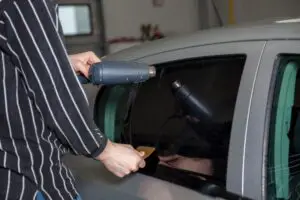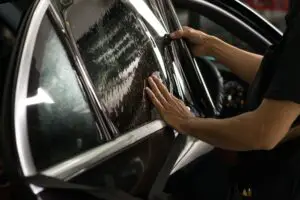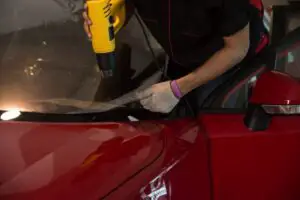In 1992, the state of South Carolina enacted window tinting legislation.
South Carolina has then stayed tough with its laws and regulations since then. Any state in the United States’ constitutions can shift at any time.
If you want to acquire a car with tinted windows or retain one fitted, you must be completely informed of the South Carolina window tinting rules.
South Carolina has laws and restrictions regarding how dark or reflective tint is permitted, and you certainly do not want to go against those laws as they can put you in a lot of trouble.
There are different rules for windows on different vehicles, which I will discuss further.
South Carolina window tint laws say that windshields must use non-reflective tints, mainly on the top of the manufacturer’s AS-1 line.
The front side windows should permit more than 27 percent light inside the vehicle.
If you want to tint all the windows of your vehicle, then it will be best for you to continue reading this article and find out in detail the percentage of VLT allowed, so you are following the law.
I have also included a frequently asked questions section, so make sure to read that, as it is highly informative.
Table of Contents
- 1 How Much Tint Darkness Is Legal In South Carolina?
- 2 Window Tint Reflection And Tint Colors
- 3 Medical Exemption Of Window Tint Laws In South Carolina
- 4 Get A Certified Sticker From The Company
- 5 Other Window Tint Law Rules And Regulations In South Carolina
- 6 Cost Of Car Window Tint In South Carolina
- 7 Frequently Asked Questions
- 8 Conclusion
How Much Tint Darkness Is Legal In South Carolina?

To find out how much tint of darkness is legal in South Carolina, you need to learn it through the help of VLT.
It is also known as Visible Light Transmission, and it is explained to be the percentage of visible light permitted through the windows of your vehicle.
In South Carolina, the percentage of light permitted passing the film and the glass is highly particular and differs for sedans, SUVs, and vans.
Here is an example; if the tint should be more than 15%, it will need 15% visible light transmission. I will be discussing the percentage, so be sure to read this very carefully.
Tint Darkness Limit For SUVs And Vans
Starting with SUVs and vans, you must know that the tint darkness limit for all their windows must be followed according to the law if you do not want to get into problems.
To begin, the windshield of these vehicles must use non-reflective tint only. It is permitted only on the top of the manufacturer’s AS-1 line.
Furthermore, the front windows must allow more than 27 percent visible light transmission inside the vehicle.
Moreover, the back seat side windows are allowed to use any darkness limit to the top of the window by numerous unidentified inches.
Lastly, the rear windows of these vehicles are also allowed to use any darkness.
Tint Darkness Limit For Sedans
Now let’s move on to the tint darkness limit for sedan vehicles. The laws are slightly different for this vehicle, so pay close attention and follow if you own a sedan car.
1. Front Windshield
On the other hand, the windshield must only use a non-reflective tint.
Keep in mind that it is entitled only on the top of the manufacturer’s AS-1 line. There isn’t any mention of using it on the top of the windshield.
2. Front Seat Side Windows
Starting with the front windows, you must know that there should be more than 27 percent visible light. With this level, you will not have difficulty driving.
3. Rear Window
The rear window should also let over 27 percent of visible light transmission so you can reverse better.
4. Back Seat Side Windows
Lastly, the back windows must also let more than 27 percent visible light inside the vehicle. It cannot be less than that.
Window Tint Reflection And Tint Colors
- Window tinting is one of the reasonable things you can do for your vehicle to prevent strong sun rays from getting inside your vehicle and making it extremely hot.
- There is also a specific window reflection that is allowed in South Carolina.
- The tint reflection for sedans, SUVs, and vans’ front side windows should only be non-reflective.
- This also goes the same for the back side windows of all these vehicles. However, the state of South Carolina did not stipulate what exactly this implies.
- Red, yellow, and the color amber are strictly prohibited.
- If your vehicle is seen with these tinted colors, you can be fined in South Carolina.
Medical Exemption Of Window Tint Laws In South Carolina

If you have a serious medical condition, you are allowed to be medically exempt in South Carolina.
However, you might need to consult the state law to determine what specifically specifies you to get a medical exemption, as there are strict laws for certain things.
It is also worth mentioning that whatever driver that gets a medical exemption in South Carolina is allowed to tint their automobile windows to any level.
To qualify for this exemption, you need to obtain a note from the doctor stating that you require window tinting for medicinal purposes.
After your medical exemption is accepted, apply for stickers to place on the car.
Other than that, keep the letter in the vehicle with you while driving so you can show it to the police officers if you ever get stopped by them.
Get A Certified Sticker From The Company
To designate lawful window tinting in South Carolina, the state legislation strongly suggests obtaining a sticker for window tinting, which must be positioned in the middle of the film and the glass of the tinted windows.
Keep in mind to take the statement to the local motor vehicle department after you’ve received it from the doctor and put in your information so they can provide you with an exemption sticker to put on your vehicle.
It is preferable if you keep them in your vehicle.
Other Window Tint Law Rules And Regulations In South Carolina
If you have made up your mind about tinting your windows, read these additional rules to be thoroughly cautious of what you can and not do.
- Dual mirrors are essential for your windows if the backside windows are tinted.
- Before you buy a film, ask the dealer if it is authorized. This is because manufacturers need to certify the film first.
- Make sure to get stickers for legal tinting and position them in the middle of the glass and film where it is easily spotted.
- If you need special tinting done on your windows due to a medical condition, then South Carolina permits getting a medical exemption.
- Each infraction is a misdemeanor punishable by a minimum punishment of $200 or 30 days in jail.
These rules must be respected and followed if you tint your car’s windows in South Carolina, or you might have to face the consequences.
Cost Of Car Window Tint In South Carolina
The cost of car window tint laws in the state of South Carolina can cost somewhere around $50 up to $600, but of course, depending on what you are looking for and how many windows you are tinting.
Keep in mind that this was the price for a standard non-reflective tint.
Now, if you wish to get a more high-quality tint, such as ceramic quality as well as metallic, then that can cost between $100 to $800.
Frequently Asked Questions
Q1. Is 15% Tint Legal In South Carolina?
No, 15% tint is not legal in South Carolina. You cannot go below 27% in passenger vehicles.
However, for multipurpose vehicles, you can use any darkness on the backside and rear windows.
Q2. Are 5% Tints Legal In South Carolina?
5% tints are not legal in South Carolina. It is too dark and can cause visibility problems. However, if you have a medical exemption, you can choose any darkness.
Q3. Is Limo Tint Legal In South Carolina?
The film used on the back side windows as well as on the back windshield is allowed to be as dark as you desire, which means you can use the extra dark limo tint film on such windows.
Otherwise limo tint is not legal in South Carolina.
Q4. Can I Get Pulled Over For Tint In South Carolina?
Yes, you can get pulled over in the state of South Carolina because they are extremely strict about their laws. You can also end up with fines or even end up in prison for up to 30 days.
Q5. How Much Is A Tint Ticket In South Carolina?
South Carolina has stronger window tint restrictions than various other states, with severe penalties, and the ticket would be $200.
If you break tinting regulations more than once, you could face punishment or perhaps 30 days in prison.
Conclusion
The provincial law enforcement may analyze the state tint legislation differently. This is why it becomes necessary to call the DMV as well as the police department in your county.
You may be wondering why is that? Well, to ensure that you are not breaking any South Carolina tint laws.
Do keep in mind that it is always preferable to be careful rather than simply being aware. And I’m quite certain that you do not want to end up in hot water.
So make sure that you are following the rules at all times and making sure to yourself up to date with all the laws.

I am Tahir Azam, and I have been writing amazing articles for TaxiHack for as long as I can remember. I know everything that is to know when it comes to automobiles and is always on top of industry news and developments. While I am not an expert by any means, I pride myself on knowing the ins and outs of many different problems and, of course, their solutions. The articles on our website are some of the best and well-researched content that you will find, and I spend countless hours making sure this remains to be true. This is why I ask you to take your time out and read some of my articles, especially if you find a topic that resonates with you or is something you are looking into. This way, you will find the perfect mix of information and tips on your desired topic. Learn more about Tahir.



